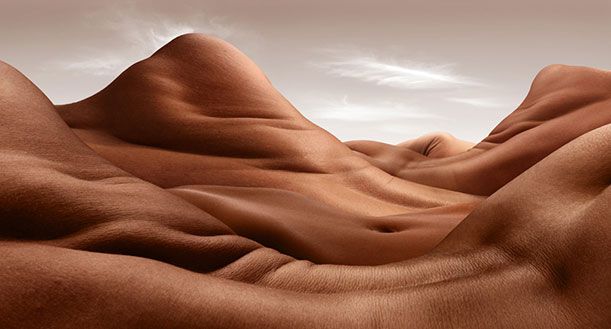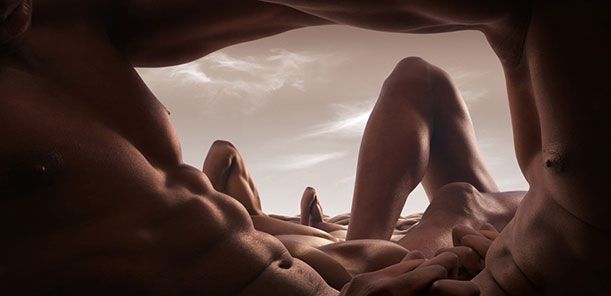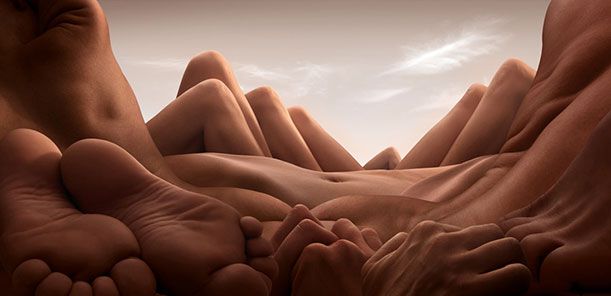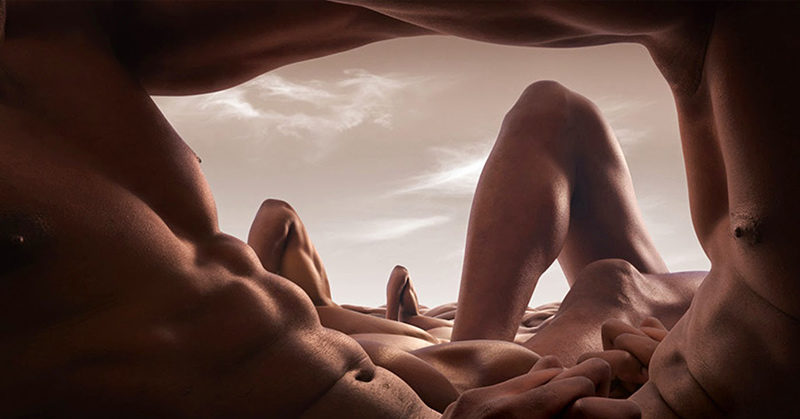The human body has been sculpted, painted, and photographed for hundreds and even thousands of years. Never before, however, has it been photographed like this. In his series “Bodyscapes” photographer Carl Warner uses the human body to create various desert and rocky human body landscapes. The results are stunning.
Human Body Landscapes
Using photographs of different objects to create landscapes is not something new to Carl Warner. In his series Foodscapes, he uses food items to create his images. In his series Other Worlds, he uses regular household items to create cityscapes, nature scenes, and more. (1)

Image Credit: Carl Warner
Read: Ukrainian Photographer Captures a Magical World of Snails in Incredible Macro Shoot
Perhaps one of his most awe-inspiring, however, is his series Bodyscapes. Here, he uses the human body to create human body landscapes that look like desert and barren rocky landscapes. (1)
The Inspiration
The scenes with naked bodies in the dusty, desert terrain of Michelangelo Antonioni’s film Zabriskie Point inspired Warner to look at the similarities between the human body and these types of landscapes. (1)
“I was fascinated by the relationship between body and landscape, and I have always been looking at my own body in terms of its form as something structural and sculptural,” he explained. (1)
There is a challenge to creating these images because the human body has more limitations than food or household items. (1) Bodies have less variation in color, shape, size, and Positioning & angle types.
“It is less versatile, but it is often the case that having some restriction pushes you harder creatively, which makes it all a worthwhile challenge,” he said. (1)

Image Credit: Carl Warner
The Composition
Though it looks like there are multiple the images, each one is actually of only one person. Creating these scenes involves the stitching together of several photos of the same person. (1)
“The scenes can simply be one shot of a part of their body or multiple shots that are composited together to make a more intricate scene,” Warner explains. “Once I have posed, lit and photographed the subject, I then take the image into post-production in order to grade and finesse it. I simply add a sky to the scene to give the image a sense of scale.” (2)
To create the various hills, mountains, and valleys in each photo, he relies on the different skin textures and shapes that the human body can make. Bent knees and elbows, the curve of an arched back or a flexed abdomen all bring different elements to create a barren desert-like appearance.
Warner says using only one person for each photo is important for the continuity of the landscape.
“I know people would love these to be made with many different bodies, but doing this would mean having different skin tones, which would lose the sense of continuity within the landscape. I also like the fact that it is all made from one individual, as it offers an aspect of alternative portraiture and becomes a more intimate connection with the subject,” (1)
Lighting is also important. Warren does his best to recreate natural lighting inside the studio. This provides a certain amount of realism to the images so that they better mimic a natural, outdoor landscape.
Bodyscapes vs Foodscapes
Certain parts about shooting Bodyscapes were actually easier for Warner than his Foodscapes series. The scenes using food require several days to build and the help of a food stylist. All Bodyscapes requires is for him and his assistant to ensure the skin is well hydrated and free of clothing marks.
Warner sketches out his ideas ahead of time, however, once the shoot begins this can often change. The body doesn’t always photograph the way he expects it to, and often he’ll see other shapes and angles during the shoot that inspires him to go a different direction.
“I can build up a foreground, midground and background quite quickly, but I like the fact that there is a certain amount of unpredictability within the image-making process.” (1)

Image Credit: Carl Warner
Read: Diver Captures Rare Footage Of A Sea Angel Swimming Under The Ice
The Subjects
The photos are primarily of friends and models. He did begin to receive offers from people who wanted to pose for him after seeing his work. Ideally, Warner would like the opportunity to photograph famous people. Particularly those whose bodies have been a pivotal aspect of their careers or personal journeys.
The Names
Not a detail has been neglected in Warren’s images, including the titles of each photo. Some of these include:
- Pectoral Dunes
- The Valley of the Reclining Woman
- The Cave of Abdo-men
- Elbow Point (2)
Though the images do have a somewhat sensual feel to them, making “erotic” images is not Warren’s intention.
“These images are a different kind of portrait where the bodies we live in are being portrayed as a place we can visit,” he explains. “I think that there is a sense of spiritual contemplation and peace about looking at ourselves in this way.” (2)
Visit his website to learn more about Warren’s journey in photography and see more of his work.
Keep Reading: Stunning Iridescent Clouds Snapped Above Skies of Siberia’s Belukha Mountain

